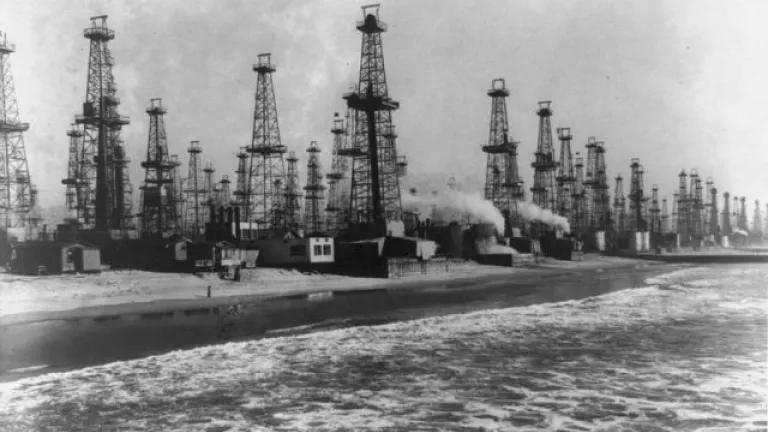Time to Bring CA Oil Drilling Law into the 21st Century

California is, in so many ways, leading the nation toward a clean energy future. Our state has time and again taken bold and forward-looking steps to diminish our consumption of polluting fossil fuels: establishing world class clean cars standards, setting a target of 100 percent clean electricity by 2045, ensuring efficient homes and buildings; working to reduce carbon emissions by 40% below 1990 levels by 2030, and leading the country in the number of zero-emission vehicles on our roads.
And now, we have a legislative proposal to bring California’s regulation of fossil fuel production operations into the twenty-first century as well. AB 1441, by Assembly Member Marc Levine, would reform the antiquated statute that has been governing oil and gas drilling in California since 1939. Levine’s bill updates language in the statute that states an outdated policy of maximizing production; re-tools the statute’s drilling authorization provisions; and provides for notice to local communities before operators commence drilling.
The 1939 statute is replete with language implying that California’s public policy favors maximizing the amount of fossil fuel we take out of the ground. It states that the Division of Oil, Gas, and Geothermal Resources (DOGGR), the agency charged with regulating oil and gas drilling in California, shall supervise drilling operations so as to permit all extraction methods “for the purpose of increasing the ultimate recovery of underground hydrocarbons”; and shall “encourage” the development of oil and gas resources. Similarly, the statute governing oil production from the state’s tidelands—which would be reformed by Levine’s companion bill, AB 1440—states that “the people of the State of California have a direct and primary interest in assuring the production of the optimum quantities of oil and gas from the lands owned by the state, and that a minimum of oil and gas be left wasted and unrecovered in such lands.”
Some of that language may have made sense in the oil industry’s younger days. Around the turn of the last century, oil and gas production was for all intents and purposes an unregulated free for all. In the absence of modern regulations governing well spacing and construction, the oil rigs were practically sitting on top of one another as drilling operators competed to be the first to capture oil. The result was a lot of wasted oil and gas. These Darwinian drilling strategies frequently resulted in underground water infiltration, which made some of the oil unrecoverable altogether. Given that history, it is somewhat understandable why the legislature required DOGGR to regulate “for the purpose of increasing ultimate recovery.”
Now, however, that language has been rendered unnecessary by the sea change in drilling practices implemented by regulators and industry, such that modern wells are as a matter of course leased, spaced, and operated in ways that maximize recovery. It is no longer necessary to specify maximizing recovery as a primary regulatory mandate.
Moreover, and more critically, facilitating maximum oil production no longer makes sense given our current knowledge of the significant public health and environmental risks associated with it. During the many decades since the original DOGGR statute, we have developed a clear understanding of the public health harm associated with proximity to fossil fuel production. Study after study shows that the closer people live to such production wells, the more likely they will be exposed to toxic air contaminants and the more elevated their risk of associated health effects, including increased risk of asthma, premature births, high-risk pregnancies, and cancer. The DOGGR statute was amended in subsequent years to add a provision stating that DOGGR should seek to prevent environmental and public health harm, but the legislature didn’t specify how that mandate would mesh with the mandate to encourage production. AB 1441 would ensure that public health and environmental concerns would consistently take precedence in DOGGR’s decisionmaking.
AB 1441 also fixes the process by which DOGGR would approve oil and gas wells. Currently, the system is heavily geared toward the convenience of drilling companies rather than protection of the public. It provides that anyone seeking to drill or re-drill a well need only provide “notice of intention” to commence drilling—and the notice is deemed approved if DOGGR does not respond within 10 days. AB 1441 retools the system to require a permit application, not merely a “notice of intention”; requires that the application be considered in a manner consistent with the Permit Streamlining Act, enacted in the 1970s to govern agencies’ permitting processes; and allows permit issuance only upon an affirmative finding that the proposed drilling project will not harm public health and the environment.
Finally, AB 1441 would require that drilling companies give timely notice to nearby land owners and residents before they start up operations. This represents a bare minimum requirement to ensure that communities threatened by the health impacts of drilling operations have time to take steps to protect themselves, and to seek answers to any questions or concerns they may have.
We are hopeful that the California legislature will welcome the opportunity afforded by Assembly Member Levine’s bills to once again show that our state is leading the way toward both strong environmental protection and forward-looking energy policy. Our state’s bold efforts to protect people and our environment from polluting fossil fuels needs a modern DOGGR statute that stringently controls rather than encourages the production of those fuels.




